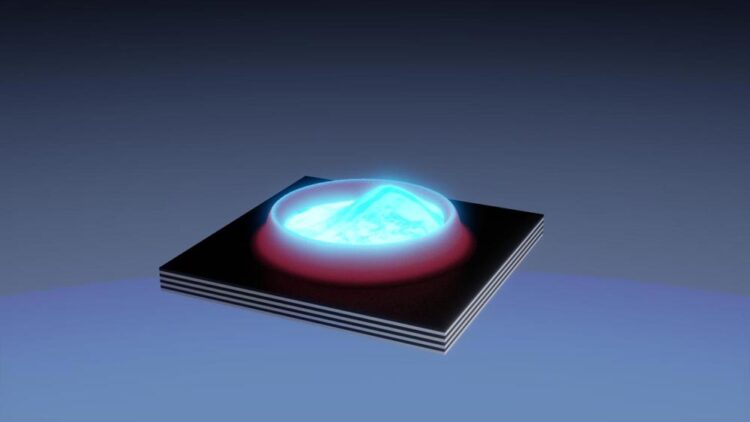Sloshing quantum fluids of light and matter to probe superfluidity

A containment 'bucket' (in red) holds the light-matter condensate (blue)
Credit: FLEET
‘Sloshing’ of a quantum fluid comprised of light and matter reveals superfluid properties.
An Australian-led team of physicists have successfully created sloshing quantum liquids in a ‘bucket’ formed by containment lasers.
“These quantum fluids are expected to be as wavy as the oceans, but catching clear pictures of the waves is an experimental challenge,” says lead author Dr Eliezer Estrecho.
Led by the Australian National University (ANU), the team serendipitously observed the wavy motion of the quantum fluid in an optically-controlled bucket, gaining new insights of the intriguing superfluid properties of this peculiar, hybrid light-matter system.
Superfluidity is the flow of particles without suffering resistance, and is pursued by FLEET researchers for future applications in ultra low-energy electronics.
FILLING THE BUCKET WITH THE QUANTUM FLUID LED TO SLOSHING
The team performed the experiments in a laser-made ‘bucket’ that traps particles called exciton-polaritons, which are hybrid light-matter particles in a semiconductor.
As these particles cool down they form a giant quantum object called a Bose-Einstein condensate (sometimes referred to as the fifth state of matter), in which quantum phenomena can be seen on a macroscopic scale.
“The excess energy lost by the cooling particles does not disappear easily so the condensate will display some sort of wavy behaviour, which is random for every realisation of the condensation,” says corresponding author Prof Elena Ostrovskaya.
That randomness makes it hard to detect the transient oscillations with the imaging cameras, since it will average out in the experiment.
However, fortuitously, the ‘bucket’ is tilted.
“In most experiments, we try to avoid the tilt since it complicates the analysis,” says Dr Estrecho.
“But in this case the ‘annoying’ tilt enabled the observation of the oscillation because it is favourable for the condensate to slosh along the tilt direction.
The sloshing oscillation was observed in both the position and momentum of the condensate, beautifully displaying the laws of quantum mechanics at a macroscopic scale that can be seen by an ordinary microscope. However, the oscillations are extremely fast, so that it was only possible to observe them using a camera with a picosecond-scale temporal resolution.
STUDYING THE SPEED OF SOUND IN SUPERFLUIDS
The true beauty of the experiment lies in the analysis of the oscillation frequencies since it is directly related to the speed of sound and can probe the superfluid properties of the quantum fluid. This is especially relevant since this peculiar quantum fluid can exist at room temperature, and hence is promising for device applications.
Using a clever analysis, the team has extracted the speed of sound from the experimental data, and found that it is smaller than expected from prevailing theories. The team argued that the discrepancy arises from the existence of an invisible reservoir of hot matter-like particles that interact with the hybrid light-matter particles.
Furthermore, the experiment also provides clues on the possible effects that can slow down the superfluid. At absolute zero temperature, the oscillations are expected to never end since the system is a superfluid. However, at finite temperature, this is not the case, so studying the damping rates of the oscillations is essential in understanding the superfluid.
Initial results show that neither the reservoir particles, finite temperature, or the inherent short lifetime of exciton-polaritons can solely explain the observed damping rates. Hence, further theoretical studies that combine these effects and carefully controlled experiments are needed to better understand the non-equilibrium quantum fluid.
###
THE STUDY
Low-energy collective oscillations and Bogoliubov sound in an exciton-polariton condensate was published as an Editor’s Suggestion in Physical Review Letters in February 2021.
ANU researchers from FLEET at the Nonlinear Physics Centre and the Laser Physics Centre worked with collaborators at the Department of Physics and Astronomy, University of Pittsburgh (USA), Department of Electrical Engineering, Princeton University (USA).
EXCITON SUPERFLUID STUDIES AT FLEET
Prof Ostrovskaya leads FLEET’s research theme 2, which seeks to create exciton-polariton condensates in atomically-thin semiconductors to enable room-temperature superfluidity.
The superfluidity probed by the sloshing of the quantum fluid in this study is one candidate physical phenomena in realising a low-energy exciton transistor.
A superfluid is a quantum state in which all particles such as exciton-polaritons flow with the same momentum, and no energy is lost to other motion.
The Centre for Future Low-Energy Electronics Technologies (FLEET) is a collaboration of over one hundred researchers, seeking to develop ultra-low energy electronics to face the challenge of energy use in computation, which already consumes 8% of global electricity, and is doubling each decade.
Media Contact
All latest news from the category: Physics and Astronomy
This area deals with the fundamental laws and building blocks of nature and how they interact, the properties and the behavior of matter, and research into space and time and their structures.
innovations-report provides in-depth reports and articles on subjects such as astrophysics, laser technologies, nuclear, quantum, particle and solid-state physics, nanotechnologies, planetary research and findings (Mars, Venus) and developments related to the Hubble Telescope.
Newest articles

Innovative 3D printed scaffolds offer new hope for bone healing
Researchers at the Institute for Bioengineering of Catalonia have developed novel 3D printed PLA-CaP scaffolds that promote blood vessel formation, ensuring better healing and regeneration of bone tissue. Bone is…

The surprising role of gut infection in Alzheimer’s disease
ASU- and Banner Alzheimer’s Institute-led study implicates link between a common virus and the disease, which travels from the gut to the brain and may be a target for antiviral…

Molecular gardening: New enzymes discovered for protein modification pruning
How deubiquitinases USP53 and USP54 cleave long polyubiquitin chains and how the former is linked to liver disease in children. Deubiquitinases (DUBs) are enzymes used by cells to trim protein…


